The Milwaukee Public Museum has one of the largest Tarahumara collections in the United States.
Comprising 376 items, the majority of the items were collected during the 1930s –- a time when European trends were just beginning to affect Tarahumara material culture. An exhibit in the Museum located on the third floor within the Middle America exhibit displays only a small amount of the total collection. This section provides a more comprehensive view of the Milwaukee Public Museum pieces.
Clothing and Accessories
A wide variety of items fit in this category (approximately 55 pieces), including leather bags, cotton skirts and shirts, woolen girdles and blankets, cinta hair decorations, and ear pendants. These items represent the more traditional dress of the Tarahumara before the Western styles of blue jeans, cowboy hats, and pointed toe leather boots became popular with men of the tribe; many women have retained their traditional bright skirts and shawls (Gorney 2008 see Modern Influences).
Garments
 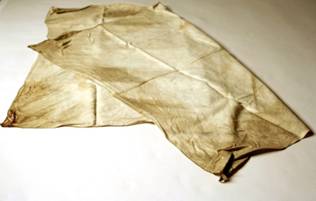 Wrap-around Cotton Skirt - sipútcaka E55661 |
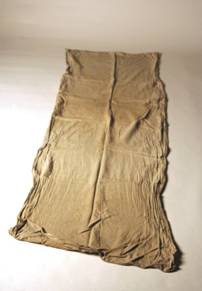  Cotton Breechcloth - sitabátca or sitagóla E55614 |
The cotton breechcloth and skirt are basic elements for Tarahumara men’s and women’s daily dress. The cotton used for these items is usually cheap, bought from Mexican settlements. There is no archaeological evidence to suggest the Tarahumara were using cotton before Spanish contact; materials used were probably pita (agave fiber - Agave Americana), rabbit skins, and feathers (Bennett and Zingg 1935).
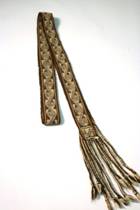

This item is referred to as a girdle if worn by men or a pukera if worn by women. The skirt and breechcloth were both worn with a woolen girdle, and “only the poorest Tarahumaras neglect giving this essential costume a decorative touch and added security by wrapping the characteristic girdle around the waist” (Bennett and Zingg 1935:100). This piece is woven from sheep’s wool dyed with lichen and black walnut husks. Not every woman possesses the talent to make these intricate garments so those that do are granted considerable prestige in the tribe.
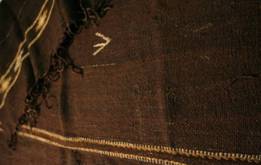

Woolen Blanket - siwátcali(E39544)
Blankets are a part of the traditional dress for both men and women in the highlands of the Sierra Madre. They are made of sheep’s wool dyed with black walnut husks to create a dark brown color and a subspecies of sunflower for yellow. These blankets are usually six feet long and are large enough to comfortably wrap one person. The Museum collection contains approximately 25 blankets.
Braid Ornaments - cinta
 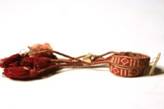 E39479 |
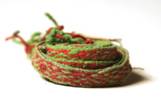  E39203 |
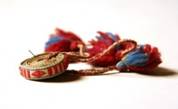  E39483 |
“Ribbons are worn by the Tarahumaras as pure decoration, without mystical associatons of any sort” (Bennett and Zingg 1930: 108). Most decorations for the Tarahumara are brightly colored. A woven cinta was usually wrapped into the braided hair of both men and women, young and old.
Utilitarian Objects
This category primarily consists of pottery and basketry items used for storage and food preparation.
Basketry
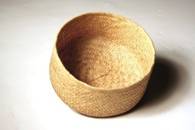  E39194 |
 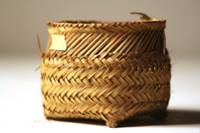 E39229 |
  E39363 |
Tarahumara basketry is “twilled” (the weft is passed over multiple warp elements to create a diagonal pattern) either with a single or a double weave. According to Bennett and Zingg, double-twilled baskets are produced by the Tarahumara that reside in the gorges of the Copper Canyon, while the people from the Sierra produce only the single weave (1935). However, both regions construct their basketry with the same general shapes, either round or square. Materials used for construction are leaves from the amole plant (Yucca decipiens), stool, or long pine needles. Basketry has recently become a tourist commodity with items being sold on the internet and at visitor stops along the Copper Canyon railway.
Pottery
  E39505 |
  E39283 |
  E39292 |
 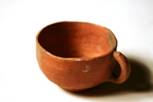 E39435 |
Tarahumara pottery is constructed of clay tempered with either sand or ground potsherds. The potter coils rolls of clay on top of each other, crimping and smoothing until she reaches the desired shape. The vessel is then left to dry and harden, before being placed into an open, dry flame. The firing process takes about an hour and a half (Bennett and Zingg 1935). A decorative slip made of red ocher powder and water is usually applied to eating vessels and the occasional tesgüino pot. In the upper regions of the Sierra, white clay is used. The addition of the red ocher slip creates a striking contrast used on more elaborate festival ware.
Entertainment and Recreation


Racing Belt - Somáka, Wekosáka or Okosáka(E39202)
Men and women foot racers (see Defined as Runners) will wear this belt (somáka, wekosáka or okosáka) made out of leather, reeds, and the tips of deer hooves, as an attempt to keep themselves awake during multi-day long distance competitions.
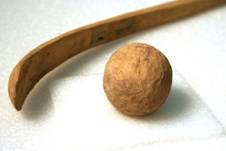

Pallilo Stick and Ball (E39417 & E39468)
Pallilo is another sport that exhibits the Tarahumara’s running talent (see Defined as Runners). The game is similar to lacrosse, with each player advancing the ball with a wooden stick. “The object of the game is to get the ball in the hand by scooping it into the air with the club and then catching it” (Bennett and Zingg 1935:345). It is a contact sport that can be compared to rugby for its intensity, but there are few rules and field constraints. According to Bennett and Zingg at the time of their ethnographic research in the 1930s, the popularity of the game was more strongly associated with the Mexicans of the area than the Tarahumara.
Hunting and Trapping
The two regions of the Sierra Madre offer a wide variety of subsistence possibilities and the Tarahumara take full advantage. The Tarahumara have many items for catching game, including bows and arrows, traps, spears, and sling shots. Most hunting and trapping items are constructed of local pine and ash.
  E39428 |
 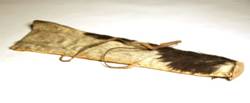 E39451 |
  E39448a-z |
Religious Paraphernalia
This category reflects the influence of Spanish and Jesuit groups. Items such as the matachine costume, crucifixes, and black Judas sticks are combinations of Christian and shamanistic rituals and beliefs. The musical instruments that fall into this grouping are a mixture of the different cultures and are used in ceremonies at different times throughout the year.
  Drum - kampóra E39507 |
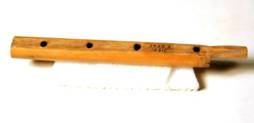  Flute E39353 |
The drum and flute are played together after the fiesta of Tres Reyes (January 12) and after Holy Week. At no other time during the year are these two instruments heard in either public or private fiestas. The drums are constructed of either ash (circular drum) or pine (square drum) and sheep or goat hide that has had the hair removed through soaking. The rounded drums “are prized because the Indian finds that he can beat them more rapidly and they are light enough to carry along the trail” (Bennett and Zingg 1935:67). The flute is made from a single joint of reed that is shaped to control pitch.
  Violin - dabéli E63910a |
 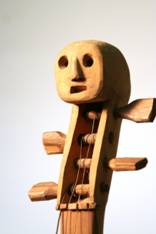 E63910a |
Violins were adopted from the Spanish in the late-16th century and are now an integral part of Tarahumara ceremonial dances (matachines) and community gatherings (tesgüinadas). This instrument is produced by a skilled Tarahumara man. Constructed of flexible ash, the piece is hand-carved. Glue is made from the boiled juice of an orchid plant. The scroll design varies, but when there is a human figure the head is always made first. The belief is that the human face makes music emanate from the violin.
Miscellaneous
  Cat Carving E63907 |
  Stylized Human Carving E63909 |
These pine bark carvings are handcrafted by Tarahumara male children. They hone their woodworking skills at a young age to prepare for adult life (see Gender Roles). It is likely that these pieces were carved to be sold to tourists.
Collection Donors
The Milwaukee Public Museum’s Tarahumara collection was primarily donated by Dr. Wendell C. Bennett and Dr. Robert M. Zingg on behalf of the University of Chicago in 1932. The donation occurred after the two anthropologists traveled to the upper Rio Urique drainage in northern Mexico to study the tribe. Beginning in October of 1930, they spent nine months performing field work and collecting data with the help of several interpreters. This collection and their monograph The Tarahumara: An Indian Tribe of Northern Mexico (1935) are the results of their ethnographic foray.
Dr. Wendell C. Bennett (1905 - 1953) was a graduate of the Anthropology program at the University of Chicago where he obtained his Bachelor’s (1927), Master’s (1929) and Doctoral (1930) degrees. He immersed himself in Latin American Studies, traveling throughout Mesoamerica and South America. He became a self-proclaimed “Peruvianist” after a trip to the Andes Mountains as the Assistant Curator of South American Archaeology at the American Museum of Natural History (New York) in 1932. Bennett held an active role in the world of anthropology. He collaborated with Dr. Robert M. Zingg on the first modern publication on the Tarahumara tribe in 1935, developed the Tiahuanaco pottery sequences of the Titicaca Basin, conducted the first properly controlled excavation in Venezuela, and in 1952 became the president of the American Anthropological Association. Dr. Bennett also was an Associate Professor at the University of Wisconsin before accepting a position at Yale, where he eventually became chairman of the Department of Anthropology.
Dr. Robert M. Zingg (1900 – 1957) was also an Anthropology doctoral alum of the University of Chicago. Zingg worked with Bennett because of their shared interest in Latin American Studies, but most of his work focused on northern Mexican peoples. His study of the Tarahumara and the Huichol tribe were the first conducted. The two studies elicited the publication of four books by Zingg: Huichol Mythology (1934), Behind the Mexican Mountains (a personal field journal) (published posthumously 2001), The Tarahumara: An Indian Tribe of Northern Mexico (1935) and Wolf-Children and the Feral Man (1942).
Other donors that added to the Tarahumara collection include:
- Anonymous (1941) - one ceramic item
- E. Nelson (1952) – eight items that include clothing, tools, and other miscellaneous pieces
- R. Weeks (1974) – a violin and a bow
- W. and V. Parker (1986) – ten items that include basketry, pine bark carvings, and a violin

